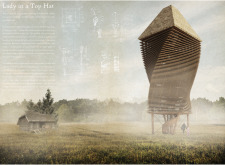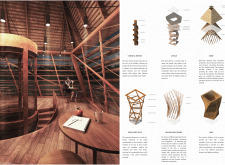5 key facts about this project
At its core, the project symbolizes a harmonious relationship with nature, drawing inspiration from the organic shapes found in surrounding landscapes. The architecture exhibits a playful twisting form that mimics the movement of natural elements, creating an engaging silhouette that invites exploration. This design approach emphasizes both verticality and fluidity, facilitating a sense of upward movement, which resonates with the imaginative notion of growth and aspiration.
Functionally, "Lady in a Top Hat" serves as a versatile space designed for various activities ranging from exhibitions to intimate gatherings. The layout is meticulously planned to accommodate diverse uses while ensuring a cohesive flow throughout the space. The ground floor welcomes visitors with an open area that fosters community engagement. Moving to the mid-level, the layout is conducive to exhibitions and interactive zones, where visitors can immerse themselves in activities and discover the features of the project. The top floor is a sanctuary that offers panoramic views, featuring quiet nooks for reflection and connection with the surrounding landscape.
The architectural design prioritizes user experience, incorporating distinctive features such as a central spiral staircase. This element not only serves as a functional component that connects floors but also enhances the artistic expression of the space. The twists and turns of the staircase mirror the overall architectural language, further establishing the flowing qualities of the structure. Additionally, the building incorporates a hydraulic elevator to ensure accessibility for all visitors, a thoughtful detail that exemplifies inclusivity and usability.
Materiality plays an essential role in shaping the overall character of "Lady in a Top Hat." Sourced sustainably, wood serves as the primary building material, providing warmth and a sense of connection to the site. The use of stone accents adds a grounding element, enhancing the robustness of the design. Steel components contribute to the structural integrity while allowing for delicate detailing that complements the organic forms. Glass is strategically used throughout the building to maximize natural light, creating a bright and inviting atmosphere that blurs the line between interior and exterior space.
The project's design embodies a commitment to sustainability, with materials chosen not only for their aesthetic appeal but for their environmental impact as well. This approach emphasizes the role of architecture in promoting ecological sensitivity, ultimately contributing to a broader conversation about responsible design practices in contemporary settings.
Unique aspects of "Lady in a Top Hat" include its innovative approach to form and space. The twisting geometry and layered levels create dynamic internal environments that promote both social interaction and personal contemplation. By placing an emphasis on the relationship between the building and its context, the design fosters a deeper connection to nature, enriching the experience for all who visit.
To gain a deeper understanding of this project and its architectural nuances, interested readers are encouraged to explore detailed architectural plans, sections, and designs. These elements shed light on the intentional decisions made throughout the creative process, showcasing how this architecture intertwines with its environment and addresses the needs of its users. "Lady in a Top Hat" stands as a testament to what thoughtful architecture can achieve, inviting further exploration and appreciation of its distinctive design ideas.


























